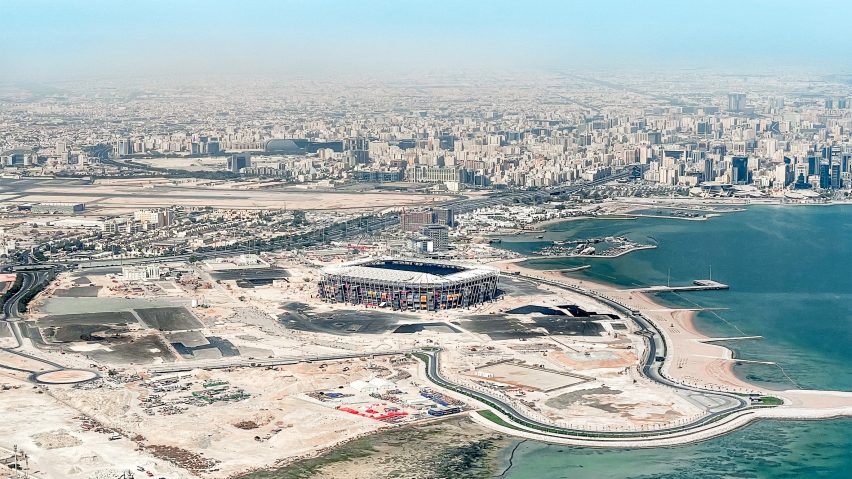
World Cup sustainability claims "built on sand" say experts
Amid widespread scepticism about the sustainability claims of the upcoming 2022 FIFA World Cup in Qatar, Dezeen asked experts if carbon-neutral global sporting events are possible.
The Qatar World Cup begins this Sunday amid a cacophony of controversy, with the environmental impact of the four-week championship coming under intense scrutiny driven by the organisers' claim that Qatar 2022 will be the first carbon-neutral FIFA World Cup in history.
"It's somewhat disingenuous, not just of the Qataris but of FIFA as well," sport and geopolitics expert Simon Chadwick said of the carbon-neutral claim.
"It's window dressing; it's built on sand," he told Dezeen.
Carbon-neutral assertion was "simply not credible"
These criticisms are on top of concerns about the Gulf state's human rights record, mainly focused on the treatment of migrant workers who helped to build stadiums for the tournament as well as Qatar's strict anti-LGBT laws.
Even Sepp Blatter, the former president of football governing body FIFA who announced that Qatar would host the World Cup in 2010, recently said the choice was a "mistake".
In a report released in June, non-profit advocacy group Carbon Market Watch said the carbon-neutral assertion was "simply not credible".
"Our goal is to offset all greenhouse gas emissions, while advancing low-carbon solutions in Qatar and the region," the event's sustainability statement reads. "A carbon-neutral tournament is delivered through a four-step process: awareness, measurement, reduction and offsetting. We are progressing rapidly in all areas."
But Carbon Market Watch argued that carbon emissions will be much higher than the 3.6 million tonnes estimated by the organisers and that the offsetting schemes which form the basis for the neutrality claim have a "low level of environmental integrity".
Several other climate experts have also expressed serious doubts.
Fossil-fuel-rich Qatar's overall environmental record is poor. The Global Footprint Network's Country Overshoot Day project, which marks the date when a nation's consumption of resources exceeds yearly planetary boundaries, put Qatar first in the world for 2022 on 10 February.
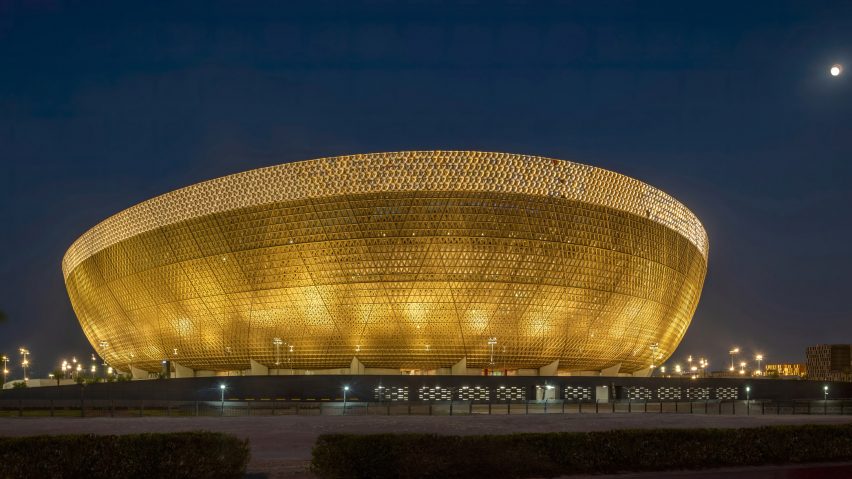
Beyond Qatar, the furore around the sustainability of this World Cup has reignited the conversation over the future of major international sporting tournaments.
"FIFA's decision to make this bold but fantastical claim has raised awareness about something many people don't think about: the impact of their favourite sports on the planet," Khaled Diab of Carbon Market Watch told Dezeen.
A similar debate raged ahead of the Tokyo 2020 Olympics, with accusations of "greenwashing". Olympic Games executive director Christophe Dubi later told Dezeen that future events will no longer involve building several new venues.
Chadwick, a professor at Skema Business School, argues that for major sporting events to minimise their environmental impact, sustainability must be built in from the start, including decisions about host location.
"Design the environment into your event when you create it," he said. "I think what we've got here with FIFA and the Qataris is post-hoc rationalisation, which is basically after the fact saying – well, okay, this is going to be an environmentally friendly tournament."
"Twelve years after they won the right to host the tournament it's a bit late now to be branding it as an environmentally sustainable event."
"It's not possible to have a global sporting event that is carbon neutral"
Claims about carbon neutrality are often controversial, especially when they rest heavily on offsetting like the Qatar World Cup.
Carbon Market Watch believes such events "should never be marketed as carbon neutral", and is dubious about whether major tournaments like the World Cup and the Olympics can achieve that standard at all.
"It's not possible to have a global sporting event that is carbon neutral, and certainly not one that involves the construction of major new infrastructure," warned Diab. "What sporting events should aim for is to minimise their climate and environmental impact, and to become more sustainable, without claiming carbon neutrality."
Chadwick is more hopeful. "I think that it's difficult and complicated to achieve, but it's not impossible," he said.
Dipesh Patel, principal and founder of BDP Pattern, a BDP-owned British architecture studio that worked on the Ahmad Bin Ali and Education City stadiums in Qatar, defended the country's approach and expressed optimism about future events.
"That the Qatar World Cup set out on a mission to be the first carbon neutral World Cup is admirable," he said. "The stadia are certainly much more sustainable than if they had been built without this goal."
"Now that Qatar has set the goal of being a 'carbon neutral' World Cup, all future major events will surely follow," he added.

"I think travelling tournaments are going to evolve significantly in the next decade," said Collective Works partner, Architects Declare steering group member and Architects Climate Action Network co-ordinator Alasdair Ben Dixon. "We're seeing much higher scrutiny over emissions which could well lead organisers to change the formats and rethink their legacy."
Both Dixon and Chadwick point to electric vehicle motorsport Formula E, which has made its world championship the only global sport to achieve third-party-certified net-zero carbon.
Before picking host cities for races, Formula E organisers undertake a sustainability audit to check, for instance, that its energy needs can be met from renewable sources.
New stadiums "incredibly lavishly constructed"
According to experts, the Qatar World Cup is particularly carbon heavy. Even FIFA's own disputed assessment put its estimated carbon emissions at over 70 per cent higher than the last tournament in Russia.
The Carbon Market Watch report highlighted the fact that of the eight Qatar World Cup stadiums, seven have been constructed from scratch.
It said that the carbon impact of the new venues, including Zaha Hadid's Al Wakrah Stadium and the Lusail Stadium by Foster + Partners, is up to eight times higher than the organisers calculate, making them the biggest contributor to the tournament's overall footprint.
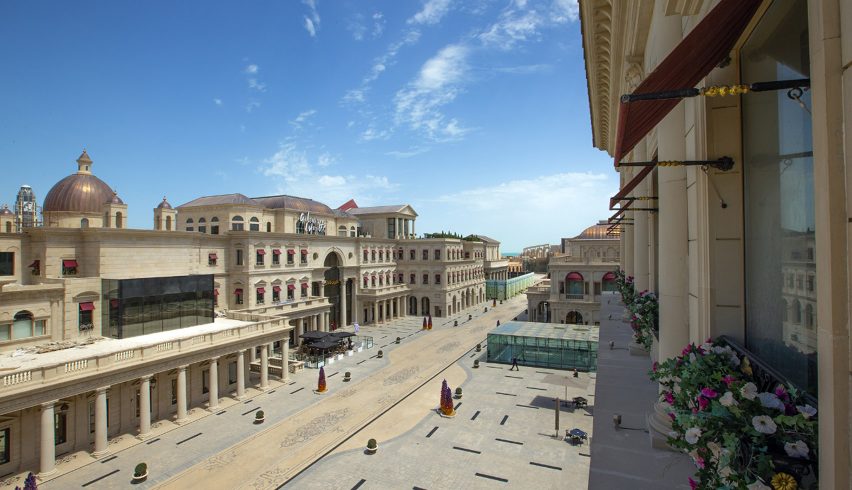
"They are incredibly lavishly constructed," said Chadwick. "But it's also important to keep in mind that it's not just the stadiums that have been created, it's the eight-lane highways and metro network to and from the stadiums."
"It's extremely unusual to have a country construct not only the stadiums, but the infrastructure to go with the stadiums, essentially from scratch," he added.
That infrastructure includes an expansion to Hamad International Airport to deal with increased air traffic during the World Cup and the new 21 High St, an air-conditioned shopping street.
World Cup "huge opportunity to research and develop" sustainable stadiums
According to the stadiums' architects, significant efforts have been made to limit the carbon impact of some of the new stadiums and infrastructure.
Most notably, Fenwick-Iribarren Architects' Stadium 974 is constructed using shipping containers, and is designed to be demounted and repurposed after the tournament, with the intention to use it for the proposed Uruguay 2030 World Cup.
In a drive to improve public transport options, the Qataris have also purchased 700 electric buses to ferry spectators around the compact tournament.
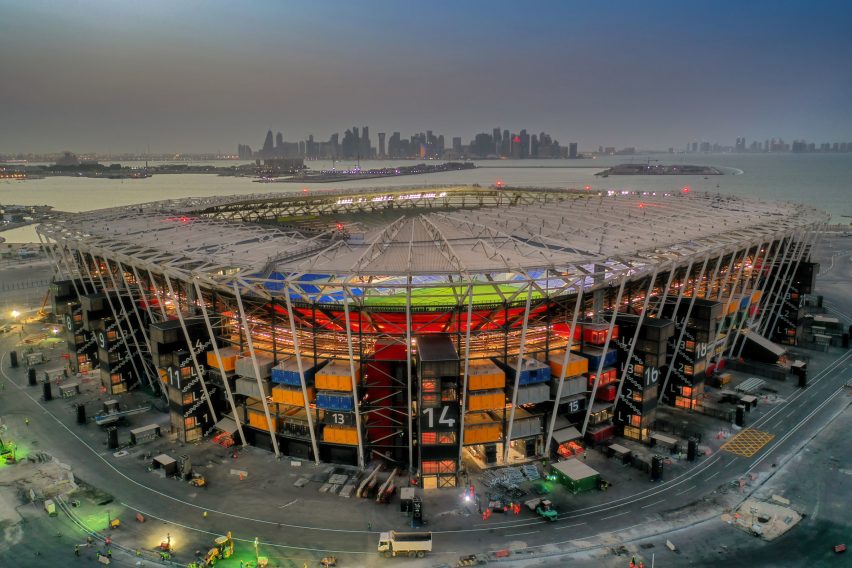
BDP Pattern's Patel argues the World Cup has represented significant strides forward.
Nearly half the capacity of both venues his practice helped create is modular meaning seats can be removed and reused elsewhere, he said, while the Ahmad bin Ali Stadium reuses materials from the arena that previously stood on the same site.
"Qatar has given the international architects and engineers involved a huge opportunity to research and develop the challenge of sustainable stadia in a very hot climate," Patel told Dezeen. "As designers we know so much more now than we did before the Qatar World Cup came along."
Post-tournament legacy
A key element when considering the World Cup stadiums' potential sustainability is their legacy after the tournament has finished.
"Trophy venues for one-off events are not acceptable," said Patel. "It is therefore of the utmost importance to ensure a lasting legacy after the major event."
Of the six permanent new venues, Education City Stadium will become home to Qatar's national women's football team as well as hosting classrooms. Ahmad Bin Ali Stadium will act as the home ground of Qatari Stars League team Al Rayyan FC.
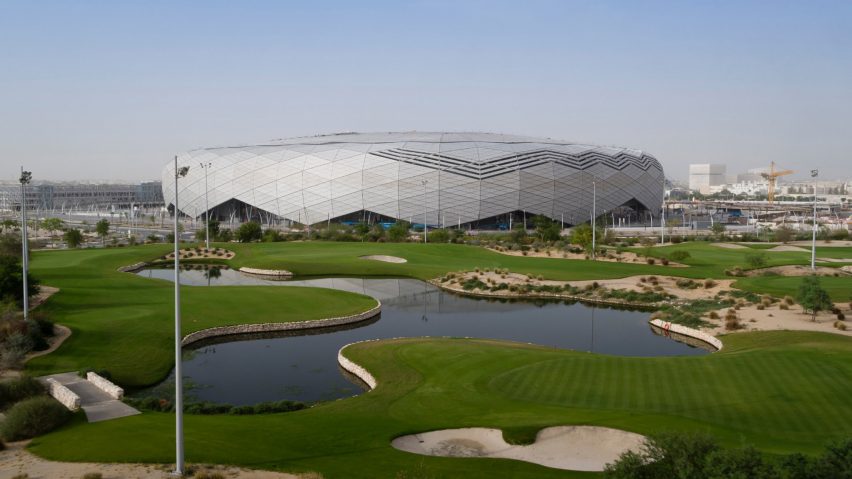
Two other stadiums – Al Thumama Stadium by Ibrahim M Jaidah and Al Bayt Stadium by Dar Al-Handasah – will be partially converted into hotels.
But some have raised doubts about whether Qatar – a nation of less than three million people – will be able to fully utilise six new major stadiums after the World Cup.
According to Chadwick, the country's most popular football team, Al Sadd SC, rarely gets more than 1,000 spectators at a game. Even post-seating reduction, these stadiums have many times that capacity.
Already a 15,000-seater sports arena in Lusail built for the 2015 World Handball Championships sits rarely used, he added.
"I think it is conceivable that moving forward from here, we will see a bunch of the venues probably being used, but not being used anywhere near to their optimal capacity," said Chadwick.
"The most sustainable new stadium is the stadium that does not get built," argued Diab. "Organisers of international tournaments must endeavour to make use of existing infrastructure as far as is humanly possible."
Architects have to "speak up on these issues"
As with human rights matters, Dixon believes concerns about the carbon impact of stadiums – and dubious related claims – have ethical implications for architecture firms.
"You've got to speak up on these issues," he said. "Wherever the project is you've got to consider your impact on society and the wider world. If you suspect that the sustainability claims don't add up or that human rights are at risk then it's time to consider walking away."
He added that architecture firms are often in a strong position to prevent greenwashing in their projects at events like the Qatar World Cup.
"A lot of larger firms will be selected based on their profile, and by lending their name to such projects they're bringing enormous prestige with them," he said. "If standards aren't being upheld even just threatening to withdraw could carry some weight."
At the same time, he acknowledges the ethical pitfalls of criticising Qatar too harshly.
"There's clearly a discomfort in raising these issues because no-one can be sure their work isn't causing harm and we aren't in a great position to lecture other nations," said Dixon.
"I think it isn't fair of those in the Global North to be making judgments about them in the Global South, when in reality we've been guilty of the same things in the past," echoed Chadwick.
Concerns about alleged human rights abuses have cast a shadow over the Qatar World Cup. The stadiums have been largely built by migrant workers, with the country widely criticised for the conditions experienced by these workers.
In 2016, Amnesty International accused Qatar of using forced labour on World Cup sites and last month released a report last month claiming that labour abuses are still happening "on a significant scale".
The Guardian has reported that 6,500 migrant workers have died in the country since 2010 although according to FIFA, there have only been 37 deaths connected to the construction of the World Cup stadiums.
Dezeen is on WeChat!
Click here to read the Chinese version of this article on Dezeen's official WeChat account, where we publish daily architecture and design news and projects in Simplified Chinese.